For a very long time, I was unsure about all the great things one gets to hear about the well-known backwaters of Kerala. Is it really as awesome as it is projected to be? Is it really as beautiful as depicted by the photographs or is it just the photogenic nature of water that makes it look so good? Is it simply great marketing or is there enough dough in in the place that is worth all the marketing? Is it worth all the money that you pay for the backwater cruises and houseboat trips? There were many doubts in a corner of my mind that refused to go away. I wasn’t very convinced. At least until work took me to a few places in these famed backwaters and offered me a glimpse this watery expanse. In my first houseboat cruise, I was completely sold. A row-boat trip helped add to the charm. Another trip on a small shikara boat on a day when it was raining cats and dogs made me a total fan of this rural landscape. No landscapes seemed more charming, no experience was parallel to this romance with water.
While I gear up for two more trips to the backwaters in the next few months, thanks to work that takes me there, a few pictures here from my earlier visits.
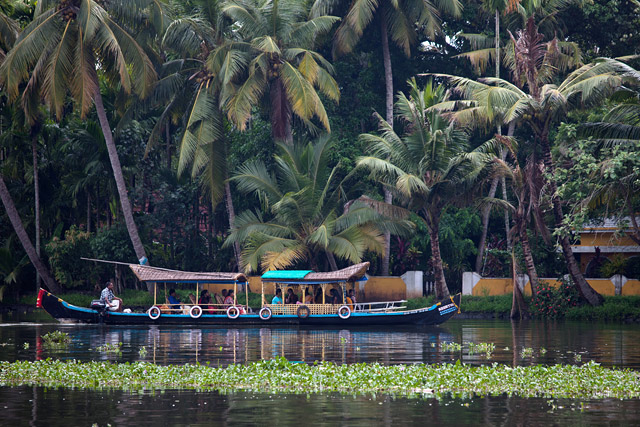
Deep in the interiors, the backwaters are so picturesque that it appears like a fairytale land. The coconut trees, the green expanse, colourful houses and beautiful boats – all reflected in the calm waters.
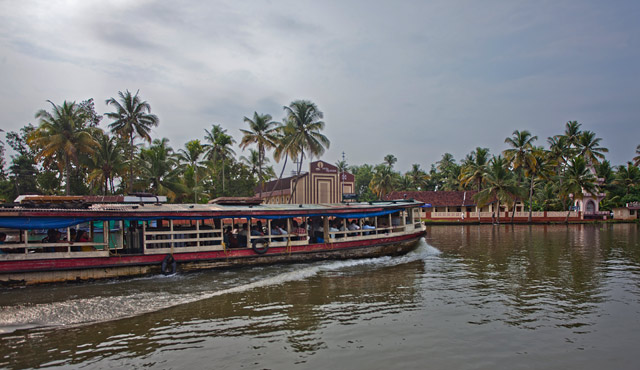
A large number of people live along the backwaters, some parts of which are islands and do not have connectivity by road. A transport network operates on the waters, very similar to roads. There are main waterways that are like highways, connected by large ferries, while the smaller channels are supported by rowboats and shikaras. A public transport network exists along the backwaters, managed by the water transport department of Kerala.
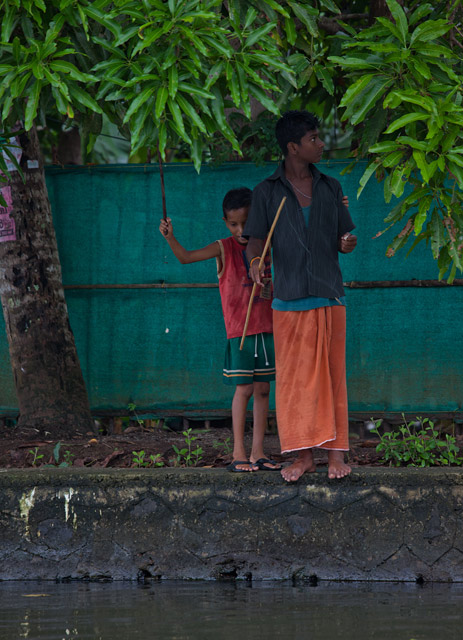
For people living in the backwaters, much of their life depends on the lake. There are many houses that face the canals, where you are right on the bank the moment you step out of the house. Some times it makes one wonder what happens to the houses when the water level rises. But since the backwaters are connected with the see, it is rare that you see the water levels rising. What is really interesting is to see some houses built below the level of water at places, protected by bunds to stop water from rushing in.
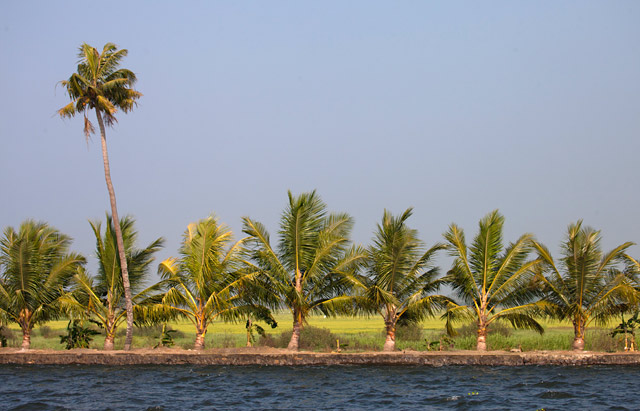
Several islands are built artificially all along the backwaters, where land is reclaimed from the lake and people have settled in to grow paddy or to rear fish. Water from some such reclaimed lands has to be routinely pumped out to keep it dry. In a curious occurrence, while farmers across the country work to bring in water and let it stagnate in the paddy fields, here in the backwaters they need to pump out excess water from the fields. Sometimes, you see just a narrow bund separating two parts of the waterways, and the strip used for growing coconuts.
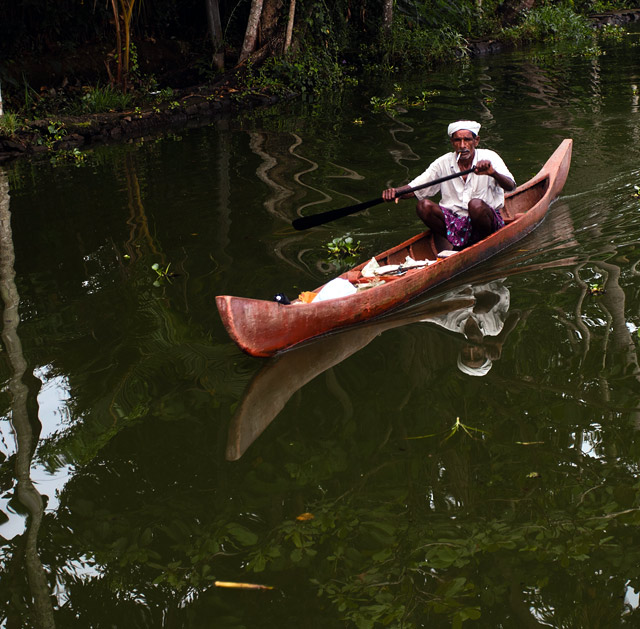
Where there are people, there will be vendors. The backwaters also serve as a marketplace. You see restaurants facing the canals, some serving the locals and some positioned for the tourists. There will be vendors selling fish, food and several type of household materials, rowing their tiny boat with their wares. People use boats of different sizes – motored and non-motored – to move goods from place to place. It is amazing how the canals are not very different from roads.
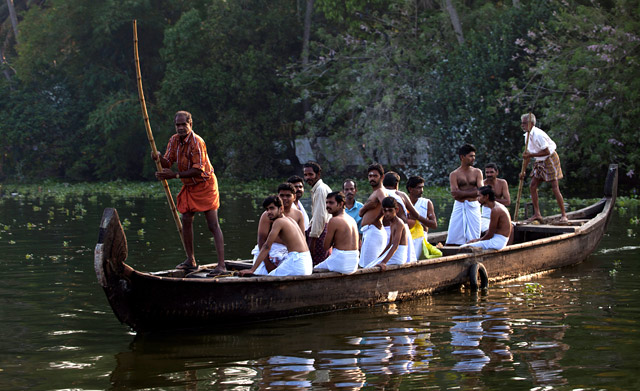
The evening sun in the winter makes the backwaters appear glorious, adding more colours to the already picturesque countryside. On my brief houseboat cruise, when I was searching for some dough for a writing assignment, I came across several interesting aspects of life along the backwaters. Here is one such moment. While I did not get a chance to speak to people in the boat, it seemed like a ritual performed for the departed soul.
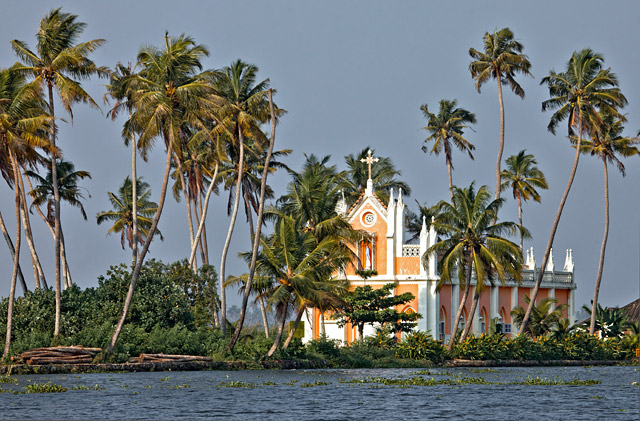
Temples, churches and mosques add a sudden burst to otherwise blue and green expanse of the backwaters. Sometimes they appear to be in a place nowhere and completely inaccessible, which is true to some extent because a lot of places in the backwaters can only be approached by a boat, with no road access to the places.
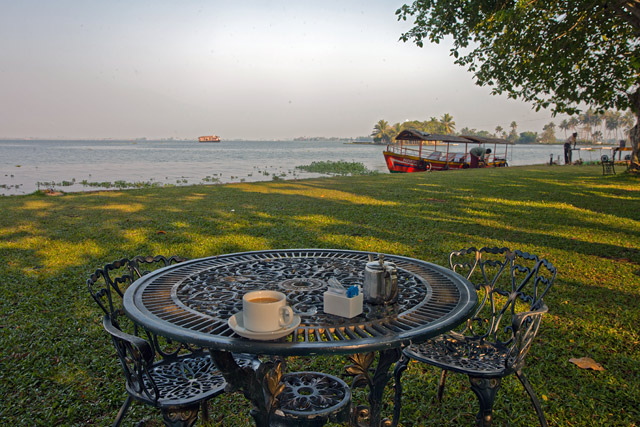
Tourism, of course, is now one of the biggest activities in the backwaters. Houseboats that once used to transport rice to the markets now troll the backwaters with tourists on board. Luxury resorts line the edge of the backwaters, offering their guests an uninterrupted view of the lake all through the day. There are many factors that might have contributed to this, including an amazing marketing effort from the government of Kerala besides the fact that this is indeed a beautiful location.
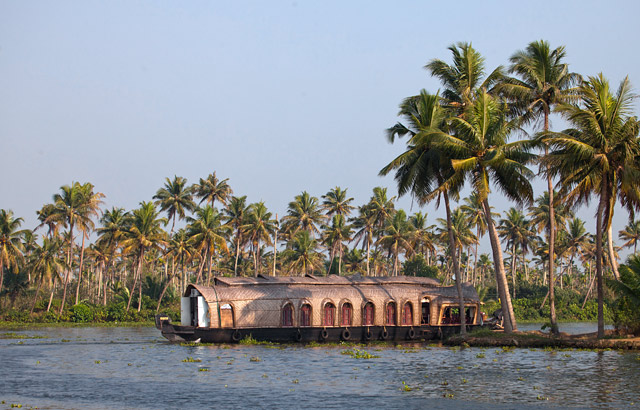
The houseboats are a great way to explore the expanse of backwaters. They come with all creature comforts – well equipped rooms and kitchen – and can effortlessly move through the vast stretch of Vembanad Lake. However, these big boats can only cruise along the major channels and are not capable of reaching the islands in the interior. To compare, travelling on them is like moving on a highway (a picturesque one this time), but missing out everything that happens along the smaller roads, where life usually unfolds closer to you. A better way to to explore the region and get up-close to the everything is to take small shikaras or row boats that can go into the smallest of the canals.
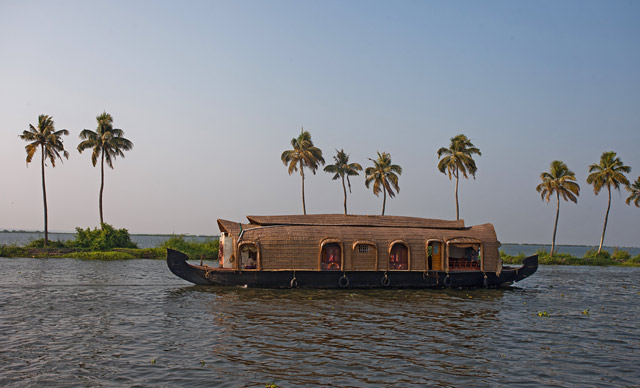
The backwaters also suffer from their share of problems, thanks to growing population, human control over water and growing tourism activity. Rules of construction are relaxed on the resorts springing up next to the lake, which are often permitted to build right next to the lake. The houseboats release many pollutants into the lake. Agricultural activity releases a large amount of fertilizers and pesticides into the lake, resulting in diminishing population of aquatic life. Water hyacinth, which strives on water with fertilizer content, is seen everywhere. Because the salinity of water is controlled artificially by bunds and locks, the variety and diversity in aquatic life has reduced over the years. However, for a visitor who is spending a brief holiday floating in the water, these problems remain faraway occurrences.
Some images can be seen at a bigger size on paintedstork facebook page
As monsoon clouds move into the western ghats in the early days of June, the hills of Chikmagalur see a remarkable transformation. The vistas of grassy slopes and the dense forests of Bhadra Wilderness disapper under a blanket of thick fog. The fog never recedes for the next three months and it looks as if the skies have disappeared, never to come back again. But come September, it goes away as magically as it had arrived to reveal the beautiful blue skies and to welcome the warmth of the sun.
Chandradrona Parvata, commonly known as the hills of Bababudangiri Hills, host the highest peaks in Karnataka and is home to some of the densest rainforests in the region. I made a dashing visit to the hills this monsoon season and made an attempt to capture the foggy hillscapes. Here is a collection of images of Chandradrona’s Fog.
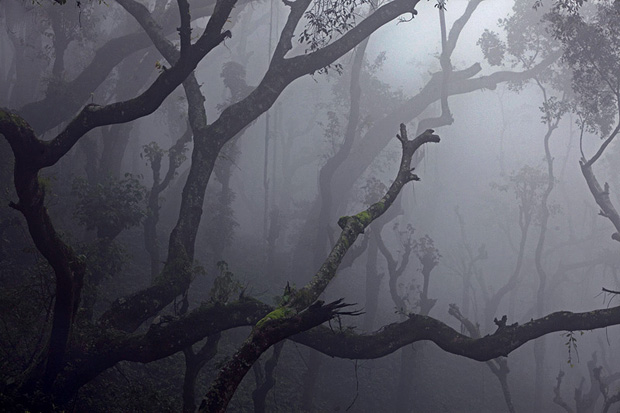
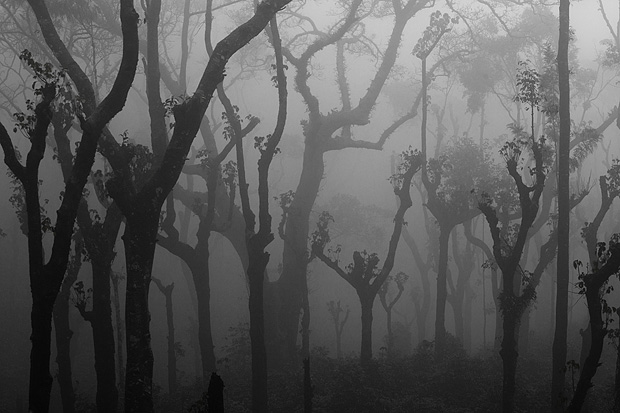
Coffee estates dominate the slopes of Bababudangiri. The district of Chikmagalur, along with neighbouring Coorg, grows bulk of the coffee produced in India. The need for a balance of sun and shade in coffee estates allows coffee growers to retain some of the trees that naturally grow in the region, but they constantly chop the branches and leaves to allow some sunshine to seep in. This creates a weird landscapes full of tall trees standing bare, often with only tender leaves sprouting from their hacked branches. Add a foggy monsoons that hides the details in the landscape and you get an eerie atmosphere in the hills.
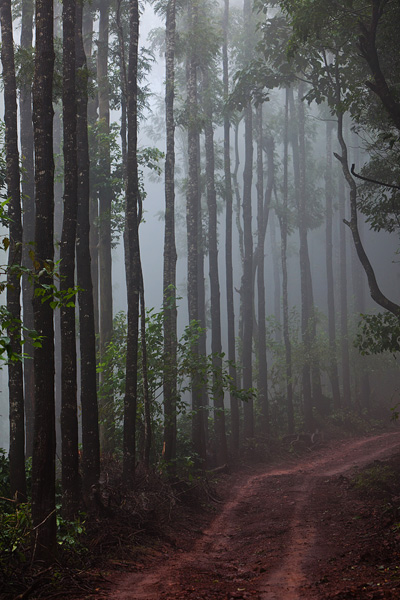
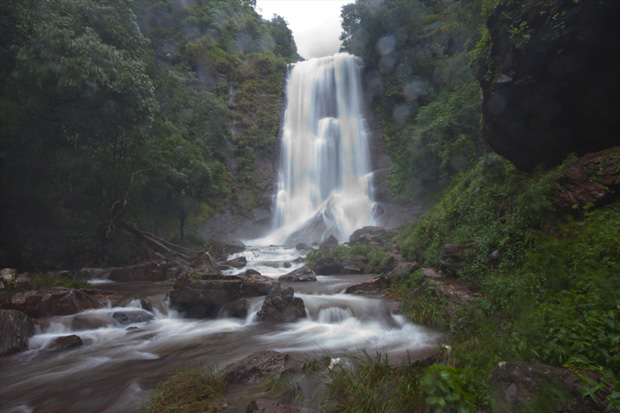
Many roads in the hills are without tarmac and sometimes you can barely call them roads. Many roads are also privately owned by the coffee estates that are spread over thousands of acres. We drove through one such road on an ancient Mahindra that lacked the luxuries of shock absorption. Sometimes we treaded over rocks when the road disappeared in stretches, each time double checking to ensure that our backs have stayed unbroken. The road lead to the roaring Hebbe Falls that was falling with full force in the peak monsoon season. I stood in the narrow valley of the stream and felt the wrath of the waterfall whose sprinkles made me completely wet in a matter of seconds. I went there determined to take a picture and decided not to step back despite being faced by a jet of droplets hurled away from the waterfall into me. Keeping the camera covered most of the time, I set it up on a tripod, composed blindly and hurriedly took a picture, exposing the camera in the open just for a few seconds. The lens surface became completely wet in those few seconds and you can see the droplets in the picture. I knew this was a task meant to fail, but I had no heart to come back without trying.
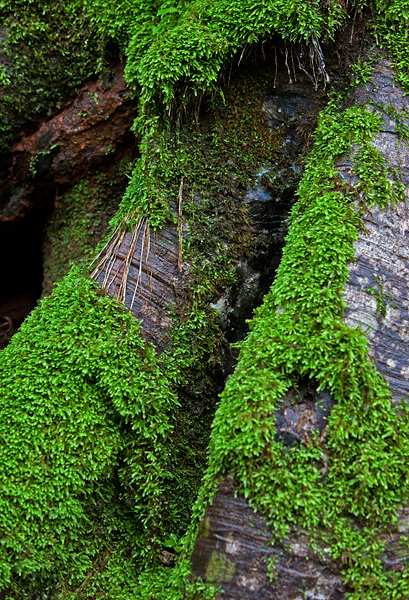
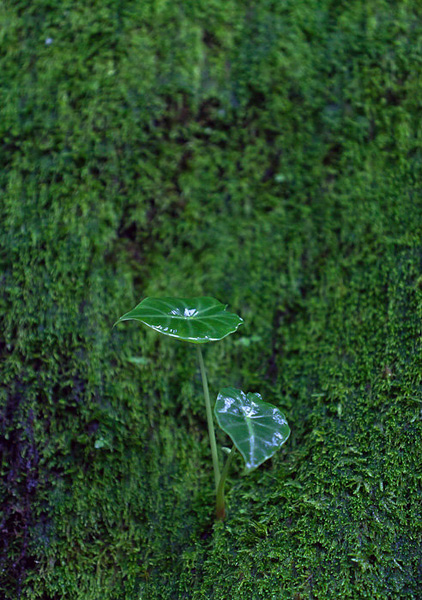
Monsoon is the season of fertility in the highlands of Chandradrona. Every exposed surface remains wet all through the three months of rain. Life in different shape, form and size grows effortlessly at the slightest opportunity; even tree trunks are never spared.
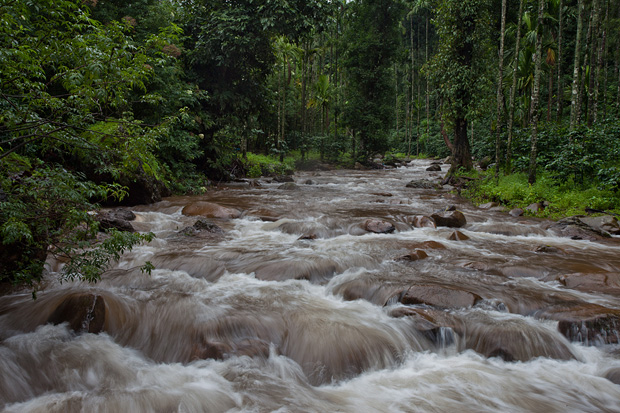
Innumerable streams crisscross the forests in these mountain, sometimes rushing down the hills in a great hurry and sometimes meandering gently through the forests. They come together in River Bhadra and feed the plains of the Indian peninsula. These streams come alive during the monsoons, charged by the continuous rains that keeps pouring throughout these three months.
Prints of all the images available. Request for prints.
I went to Thiksey Village to see the monastery, but was charmed by the barley fields around the village more than the monastery itself.
See glossary for meaning of terms marked in bold below.
On my way to Ladakh from Manali, I had presumed entire Ladakh as a calm and pleasant region with a soothing feel and a mystic charm. But the urban growth and its ugly suburbs had baffled me, making me wish to move away from the town. Thiksey provided the necessary escape.
After having gone through the barren landscapes along the Manali-Leh road and spending days in Leh looking up at arid mountains all around the town, the greenery along the Indus Valley gave a welcome break. The river basin is at its widest in Thiksey, mostly filled with barley fields, poplar groves and a few houses dotting the verdant landscape.
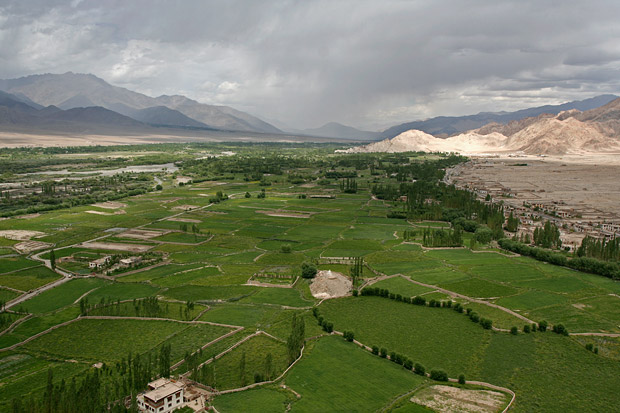
I walked through the fields listening to the cawing of bactrian magpies and watching a hoopoe lodge on the ground near me, spreading its crest like a fan and proudly demonstrating its beauty. Sparrows hopped around the fields in search of grain, chirping and flying away on my approach. The fields were crisscrossed by a complex array of canals with cold, crystal clear water coming down from the mountain peaks. A long Mani wall bordered the fields. Thin poplar trees grew tall and parallel to each other, forming boundaries between two patches of land. As the sun edged towards the mountain peaks in the west, the sky was painted in orange and shafts of light emerged from the gap in the clouds. Sunlight made way through the poplar trees, creating strips of light and shade on the ground.
A few women worked in the fields. Children gallivanted on the road, going back and forth without purpose.
Thiksey monastery was visible at a distance, perched high on a hill to the north, overlooking and guarding the village. Indus flowed somewhere below in the wide valley. Far away to the other side were the mountains of Zanskar, with their brown slopes and icy peaks. It was a beautiful world!
But there are some signs of Thiksey’s traditional barley fields giving way to development. Some fields were dug up for brick making, probably to satisfy the demand from Leh and to build accommodation for the summer rush of tourists. Poplar trees – another material used for construction – usually grown at the edge of the fields now completely occupied some areas.
As the sun went down the horizon and we headed back to our hotel, we met two soldiers from the nearby battalion. They were friendly and happy to talk, like most army men here were. Suman and Rishi have seen a winter here and can’t forget the harsh weather and sub-zero temperatures from those days.
‘It gets bitterly cold,’ they say, ‘-45C in winter. All the greenery that you are seeing today will be gone. There won’t be a shrub to see. The trees shed their leaves and look like skeletons. Nothing grows on earth. Vegetables cost ten times the summer prizes. The approach roads to Ladakh will be closed and there will be snow all over.’
Having seen a harsh winter, Suman preferred warmer climes. ‘You should go to Andamans,’ he told me, ‘see the sea there, go to Port Blair and visit the cellular jail.’ Without knowing, he was kicking up a wish I have had for a long time.
We parted ways and returned to the hotel, a place managed by the monastery administration. We intended to visit the monastery for the next morning prayers, but luck would go against us. Someone had died at the village yesterday and the monks were to go there to perform final rites. There would be no morning prayers in the monastery next morning.
To be continued..

















